

Bootstrapping Machine Learning: Book Review. Louis Dorard has released his book titled Bootstrapping Machine Learning.

It’s a book that provides a gentle introduction to the field of machine learning targeted at developers and start-ups with a focus on prediction APIs. I just finished reading this book and I want to share some my thoughts. If you are interested, I have already reviewed the sample Louis provides on his webpage that covers the first two chapters. Bootstrapping Machine Learning Overview The book is broken down into eight chapters, as follows. IntroductionMachine Learning and Artificial IntelligenceConceptsExamplesApplying Machine Learning to Your DomainPrediction APIsCase Study: Priority InboxWrap-up Prediction APIs Louis provides a taxonomy of prediction APIs in Chapter 3.
Specialized APIs: These are APIs that solve a specific problem such as sentiment analysis of tweets or face recognition in images.Generic APIs: these are general machine learning APIs where you upload a dataset and the system returns predictions. Holonic and Multi-Agent Systems for Manufacturing: Third International ... A model driven engineering process of platform neutral agents for ambient intelligence devices. Ambient intelligence (AmI) systems are now considered a promising approach to assist people in their daily life.
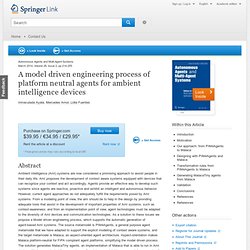
AmI proposes the development of context aware systems equipped with devices that can recognize your context and act accordingly. Agents provide an effective way to develop such systems since agents are reactive, proactive and exhibit an intelligent and autonomous behavior. However, current agent approaches do not adequately fulfill the requirements posed by AmI systems. From a modeling point of view, the aim should be to help in the design by providing adequate tools that assist in the development of important properties of AmI systems, such as context-awareness; and from an implementation point of view, agent technologies must be adapted to the diversity of AmI devices and communication technologies.
As a solution to these issues we propose a Model driven engineering process, which supports the automatic generation of agent-based AmI systems. On the use of a domain-specific modeling language in the development of multiagent systems. Abstract The study of Multiagent Systems (MASs) focuses on those systems in which many intelligent agents interact with each other.

The agents are considered to be autonomous entities which contain intelligence that serves for solving their selfish or common problems, and to achieve certain goals. Comparing the comprehensibility of requirements models expressed in Use Case and Tropos: Results from a family of experiments. Abstract Context Over the years, several modeling languages for requirements have been proposed.
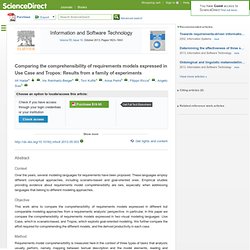
These languages employ different conceptual approaches, including scenario-based and goal-oriented ones. Empirical studies providing evidence about requirements model comprehensibility are rare, especially when addressing languages that belong to different modeling approaches. Objective This work aims to compare the comprehensibility of requirements models expressed in different but comparable modeling approaches from a requirements analysts’ perspective. Method Requirements model comprehensibility is measured here in the context of three types of tasks that analysts usually perform, namely mapping between textual description and the model elements, reading and understanding the model irrespectively of the original textual description, and modifying the model.
Results. Collaborative negotiation for ontology-driven enterprise businesses. Abstract The requirements from a globalised world demand that enterprises not only shift their paradigm from product-centrism to component-centrism on integrated products, potentiating the need for tight interoperability dependencies, but also that the product specifications and concepts are fully understood by customers and providers in a transparent manner that surpasses the barriers of language, culture and technology.
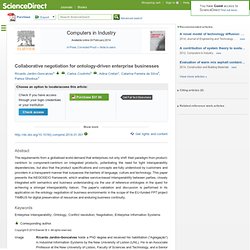
This paper presents the NEGOSEIO framework, which enables service-based interoperability between parties, closely integrated with semantics and business understanding via the use of reference ontologies in the quest for achieving a stronger interoperability liaison. The paper's validation and discussion is performed in its application on the ontology negotiation of business environments in the scope of the EU-funded FP7 project TIMBUS for digital preservation of resources and enduring business continuity. Keywords. Service-based negotiation for advanced collaboration in enterprise networks - Online First. A Model for Decision Making with Missing, Imprecise, and Uncertain Evaluations of Multiple Criteria - Ma - 2012 - International Journal of Intelligent Systems. Multiagent System Technologies: 4th German Conference, MATES 2006, Erfurt, Germany, September 19-20, 2006, Proceedings by Klaus Fischer. Towards the integration of the agent-oriented modeling diversity with a powertype-based language.
Highlights A language for integrating the agent-oriented modeling languages (AOMLs) diversity Metamodel with concept subtypes that cover peculiarities of existing AOMLs Tool support for editing models of this language, called Inter-methodology AOML Existing AOSE tools can be adapted to export models in this language, as IDK tool.
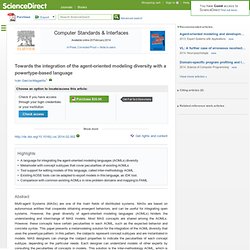
Comparison with common existing AOMLs in nine problem domains and mapping to FAML Abstract. Xplore Abstract - Towards an organizational model for Real Time Multi-Agent System specification. A Novel Organizational Model for Real Time MAS: Towards a Formal Specification. Michael P. Georgeff. (49 publications) Bibliography (add it to your website) Deliberation and its Role in the Formation of Intentions CoRR, 2013 Cost/Benefit Analysis of an Adherence Support Framework for Chronic Disease Management.
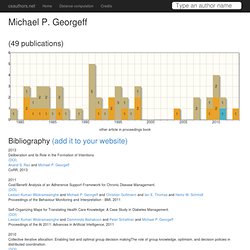
Proceedings of the Behaviour Monitoring and Interpretation - BMI, 2011 Self-Organizing Maps for Translating Health Care Knowledge: A Case Study in Diabetes Management. Knowledge Engineering for Software Development Life Cycles: Support ... Contributions to the emergence and consolidation of Agent-oriented Software Engineering. Volume 86, Issue 4, April 2013, Pages 890–904 SI : Software Engineering in Brazil: Retrospective and Prospective Views Edited By Alessandro Garcia.
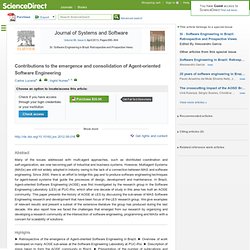
Xplore Abstract - PROPOST: A Knowledge-based Tool for Supporting Project Portfolio Management. Contributions to the emergence and consolidation of Agent-oriented Software Engineering. A Proactive Perception Model in Agent-Based Software Integration and Evolution. Introducing agent techniques into system integration and software evolution can solve the flexible and dynamic problems in the process of system integration.
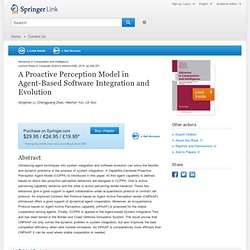
A Capability-Centered Proactive Perception Agent Model (CCPPA) is introduced in this paper. At first agent capability is defined, based on which two proactive perception behaviors are designed in CCPPA. One is active perceiving capability behavior and the other is active perceiving tender behavior. These two behaviors give a good support to agent collaboration under acquaintance protocol or contract net protocol.
Virtual organisation model: the new organisation and value chain framework - International Journal of Environmental Technology and Management - Volume 16, Number 5–6/2013. Journal Article Authors Elizabeth Freitas Rodrigues1, Paulo Roberto Tavares Dalcol2, Nélio Domingues Pizzolato3, Úrsula Maruyama4 1Industrial Business Education Department, CEFET–RJ, av.
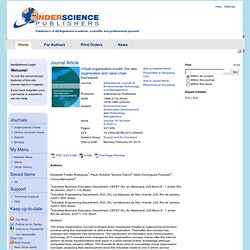
Maracanã, 229 Bloco E - 1 andar, Rio de Janeiro, 20271–110, Brazil2Industrial Engineering Department, PUC–RJ, rua Marques de São Vicente, 225, Rio de Janeiro, 22451–900, Brazil3Industrial Engineering Department, PUC–RJ, rua Marques de São Vicente, 225, Rio de Janeiro, 22451–900, Brazil4Industrial Business Education Department, CEFET–RJ, Av. Xplore Abstract - Service cooperation in PaaS platform based on planning method. Platform-as-a Service (PaaS) provides a new pattern of software design, development, testing, deployment and hosting for organizations such as ISV, business department and so on. When the PaaS platform brings together lots of software services from various organizations; it's a challenging work to construct dynamically and intelligently new application with these service resources to meet application request.
This paper pays more attention on application cooperation, namely business service process cooperation due to business process is the main form of application, in PaaS Platform based on planning method. Our approach comprises the following steps: construct abstract business process for cooperation based on the hierarchical task network planning and semantic model of service cooperation; construct executable serviceflow based on candidate services and use graph planning to verify dataflow in executable serviceflow.
On the Move to Meaningful Internet Systems: OTM 2010: International ... Grounding Ontologies with Social Processes and Natural Language. Ontologies for enabling semantic interoperability is one of the branches in which agreement between a heterogeneous group of stakeholders is of vital importance. As agreements are the result of interactions, appropriate methods should take into account the natural language used by the community during those interactions. Chapter V: SDRule Markup Language: Towards Modeling and Interchanging Ontological Commitments for Semantic Decision Making - Handbook of Rules. SDRule-L: Managing Semantically Rich Business Decision Processes.
Deontic BPMN: a powerful extension of BPMN with a trusted model transformation - Online First. Model-Driven Software Development: Technology, Engineering, Management - Markus Völter, Thomas Stahl, Jorn Bettin, Arno Haase, Simon Helsen. Systematic literature review of the objectives, techniques, kinds, and architectures of models at runtime - Online First. In the context of software development, models provide an abstract representation of a software system or a part of it.
In the software development process, they are primarily used for documentation and communication purposes in analysis, design, and implementation activities. Model-Driven Engineering (MDE) further increases the importance of models, as in MDE models are not only used for documentation and communication, but as central artefacts of the software development process. Various recent research approaches take the idea of using models as central artefacts one step further by using models at runtime to cope with dynamic aspects of ever-changing software and its environment.
In this article, we analyze the usage of models at runtime in the existing research literature using the Systematic Literature Review (SLR) research method. Communicated by Prof. Modeling dynamic adaptations using augmented feature models. Aspect-Oriented, Model-Driven Software Product Lines: The AMPLE Way. Using document-oriented GUIs in dynamic software product lines. Dynamic Software Product Line (DSPL) Engineering has gained interest through its promise of being able to unify software adaptation whereby software adaptation can be realised at compile time and runtime. While previous work has enabled program logic adaptation by the use of language extensions and platform support, little attention has been placed on Graphical User Interface (GUI) variability. Different design patterns including the Model View Controller are commonly used in GUI implementation, with GUI documents being used for declaring the GUI. To handle dynamic GUI variability currently, the developer needs to implement GUI refinements using multiple techniques.
This paper proposes a solution for dealing with GUI document variability, statically and dynamically, in a unified way. In our approach, we currently use a compile time method for producing GUI variants, and code transformations to handle these variants within the application at runtime. Runtime Evolution of Service-Based Multi-tenant SaaS Applications. Model Based Monitoring and Controlling for Platform-as-a-Service (PaaS) Abstract Platform as a Service (PaaS) is a typical cloud service paradigm that allows PaaS consumers to deploy and manage applications (usually services to SaaS consumers). To ensure the quality of services to both PaaS consumers and SaaS consumers, PaaS must be equipped with enough monitoring and controlling ability to make runtime adjustment actions.
Although most of the components in PaaS have provided their own management interface, it is hard to perform adjustment actions based on raw runtime data collected from these low level management interfaces due to the diversity and dynamics of components in PaaS. Supporting collaborative development using process models: a tooled integration-focused approach - Kedji - 2014 - Journal of Software: Evolution and Process. A characterization of integrated multi-view modeling in the context of embedded and cyber-physical systems. Software developers are humans, too! Relationships among Open Innovation Processes, Entrepreneurial Orientation, and Organizational Performance of SMEs: The Moderating Role of Technological Turbulence.
Open innovation processes have become important mechanisms that are integrated into organization’s innovation strategies to improve performance among small and medium-sized enterprises (SMEs) under dynamic technological settings. Bridging the Gap: From Open Innovation to an Open Product-Life-Cycle by Using Open-X Methodologies. Community Dynamics in Open Source Software Projects: Aging and Social Reshaping. An undeniable factor for an open source software (OSS) project success is a vital community built around it. An OSS community not only needs to be established, but also to be persisted. This is not guaranteed considering the voluntary nature of participation in OSS. The dynamic analysis of the OSS community evolution can be used to extract indicators to rate the current stability of a community and to predict its future development.
Despite the great amount of studies on mining project communication and development repositories, the evolution of OSS communities is rarely addressed. This paper presents an approach to analyze the OSS community history. DSpace@MIT: Home.